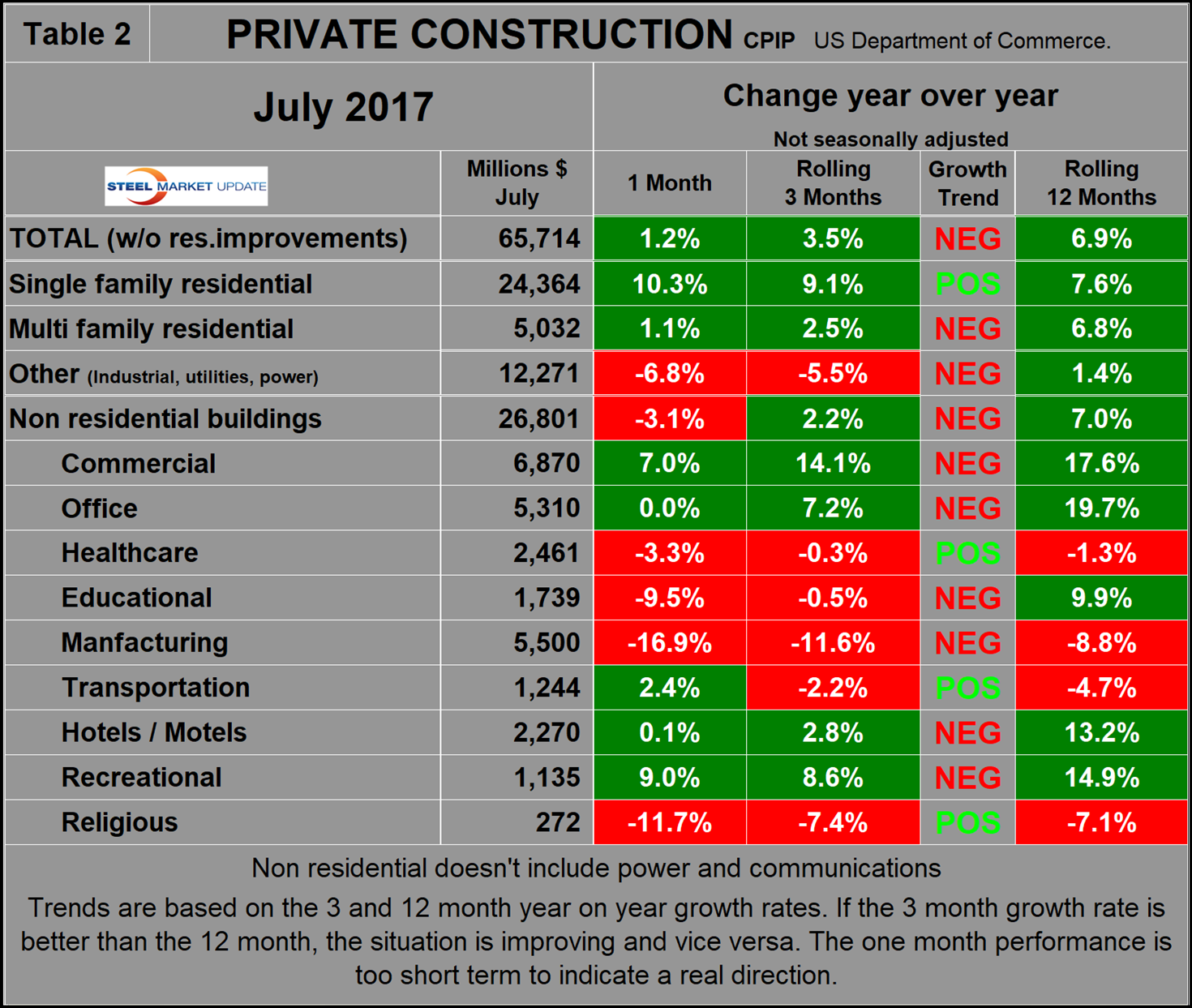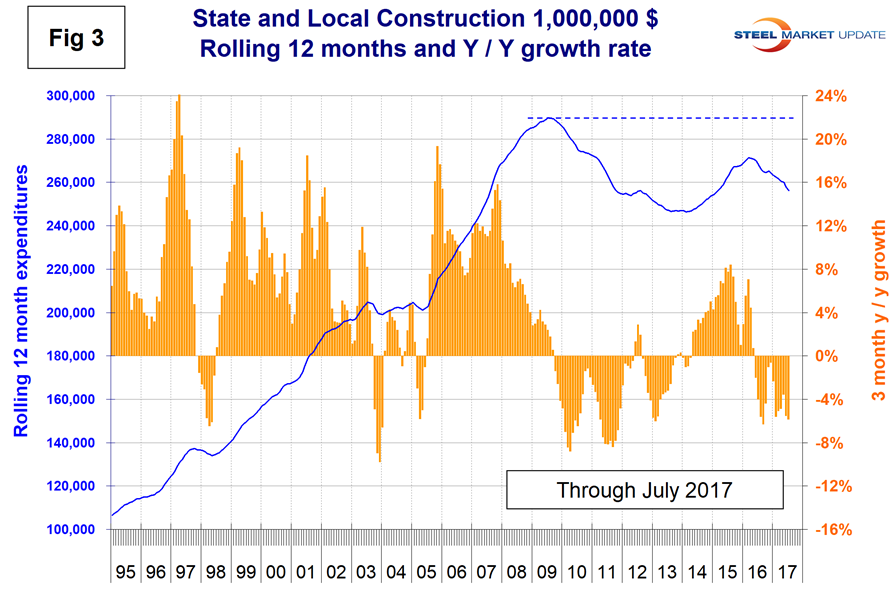Steel Markets

Construction Growth Losing Momentum?
Written by Tim Triplett
September 5, 2017
The growth of total construction spending is slowing, though still positive year over year.
July data for construction put in place (CPIP) was released by the Department of Commerce on Friday. Total construction still shows positive growth, but slowed to 0.9 percent year over year in the latest three months of data. Privately funded projects are providing all the growth, as state and local and infrastructure are both contracting. All three sectors have negative momentum. Construction is extremely seasonal; the growth or contraction that we report in this analysis has had seasonality removed by providing only year-over-year comparisons.
At SMU, we analyze the CPIP data with the intent of providing a clear description of activity that we believe accounts for more than 30 percent of total steel consumption. See the end of this report for more detail on how we perform this analysis, but note that we present NO seasonally adjusted numbers. Much of what you see in the press may differ from our presentation because others are basing their comments on adjusted values. Our rationale is that construction is highly seasonal and our businesses function in a seasonal world. Also, we don’t understand how the adjustments are made, nor do we trust them.
Total Construction
Total construction grew by 0.9 percent in three months through July year over year and by 3.7 percent in 12 months year over year. This was the 63rd consecutive month of positive growth. However, since the three-month growth rate is lower than the 12-month rate, we conclude that the rate of growth is slowing. We describe this as negative momentum.
July total construction expenditures were $91.6 billion, which breaks down to $65.7 billion of private work, $24.1 billion of state and locally funded (S&L) work and $1.8 billion of federally funded work (Table 1).
Growth trend columns in all four tables in this report show momentum. Figure 1 shows total construction expenditures on a rolling 12-months basis as the blue line and the rolling three-month year-over-year growth rate as the brown bars. Figures 1 through 4 in this analysis have the same format, the result of which is to smooth out variation and eliminate seasonality. We consider four sectors within total construction: nonresidential, residential, infrastructure and other. The latter is a catchall and includes industrial, utilities and power. All of these sectors except residential buildings had negative momentum in this latest data. The prerecession peak of total construction on a rolling 12-month basis was $1.028 trillion in the 12 months through August 2006. The low point was $665.1 billion in 12 months through April 2011. August 2016 through July 2017 on a rolling 12-month basis were the first months to exceed the trillion-dollar level since July 2008. In 12 months through July, construction expenditures were $1.035 trillion.
Private Construction
Table 2 shows the breakdown of private expenditures into residential and nonresidential and subsectors of both.
The growth rate of private construction was 3.5 percent in the three months through July, down from 11.0 percent in the three months through January as shown by the brown bars in Figure 2. In previous reports, we projected that total private expenditures would reach the prerecession high at about the end of this year. This prospect is now receding. Excluding property improvements, our report shows that single-family residential grew by 9.1 percent and multi-family residential by 2.5 percent. Single-family has positive momentum, but multi-family is slowing.
The Census Bureau reports on construction starts in their housing analysis. In the starts data, the whole project is entered into the database when ground is broken. Single-family starts grew at 8.9 percent in the three months through July, similar to construction put in place, but multifamily starts contracted by 15.3 percent. Multifamily starts have been in a severe downtrend since April and this is beginning to be reflected in the CPIP data. Within private nonresidential buildings, the commercial sector, which is mainly retail, has double-digit growth. This doesn’t jibe with the retail employment report, which has had declining job growth for almost a year. Offices, lodging and recreational buildings all have positive growth, but are slowing. The third-quarter Federal Reserve Senior Loan Officer Survey indicated that there is currently a net decrease in demand for construction, and land development loans and terms for such loans are tightening. The Fed survey reviews changes in the terms of, and demand for, bank loans to businesses on a quarterly basis based on the responses from 73 domestic banks and 24 U.S. branches and agencies of foreign banks.
State and Local Construction
S&L work contracted by 5.8 percent in the rolling three months through July year over year with negative momentum (Table 3).
This overall figure includes both nonresidential buildings and infrastructure. April 2016 was the last month in which S&L expenditures had positive year-over-year growth. Figure 3 shows growth as the brown bars and the rolling 12-month total of expenditures as the blue line. Educational buildings are by far the largest subsector of S&L nonresidential buildings at $6.85 billion in July when on a 3MMA basis year-over-year growth was negative 1.2 percent with negative momentum. Comparing Figures 2 and 3, it can be seen that S&L construction did not have as severe a decline as private work during the recession and that private work bounced back faster. The downturn in S&L (including infrastructure) means that a full recovery to the prerecession level of expenditures won’t be achieved in this decade.
Drilling down into the private and S&L sectors as presented in Tables 2 and 3 shows which project types should be targeted for steel sales and which should be avoided. There are also regional differences to be considered, for which data is not available from the Commerce Department.
Infrastructure
Infrastructure expenditures had positive growth in the first five months of last year and have had only one slightly positive month since then. In the July data, every subsector of infrastructure contracted, and only sewage and waste projects had positive momentum. Highways and streets including pavement and bridges account for about two-thirds of total infrastructure expenditures. Highway pavement is the main subcomponent of highways and streets and had a 2.2 percent contraction in three months through July. Bridge work contracted by 10.2 percent (Table 4).
Infrastructure expenditures have exceeded the prerecession high every month since July 2015, but in the last 15 months have been in a downturn (Figure 4). There is still no sign that the congressional bill for $305 billion to fund roads, bridges and rail lines that was authorized in December 2015 has begun to take effect. The long lead time for approvals and project design slows the application of available infrastructure funds, but it seems now there must be some other drag on the process. The 2015 five-year infrastructure bill was the largest reauthorization of federal transportation programs approved by Congress in more than a decade, ending an era of stopgap bills and half-measures that left the Highway Trust Fund nearly broke and frustrated local governments and business groups.
Total Building Construction Including Residential
Figure 5 compares year-to-date expenditures for building construction for 2016 and 2017. Single-family residential is dominant and in the 12 months of 2016 totaled $243 billion, up from $233 billion in 2015. On a rolling 12-month basis through July, single-family residential expenditures were $253 billion.
In the first seven months of 2017, all project segments except manufacturing, public safety, religious health care and transportation had positive growth year over year led by commercial (mainly stores), up by 22.7 percent, and offices, up by 10.4 percent. Figure 6 shows total expenditures and growth of nonresidential building construction. Growth has been slowing this year and was down to 0.9 percent in three months through July year over year.
Explanation: Each month the Commerce Department issues its construction put in place (CPIP) data, usually on the first working day covering activity one month and one day earlier. Construction put in place is based on spending work as it occurs, estimated for a given month from a sample of projects. In effect, the value of a project is spread out from the project’s start to its completion. This is different from the starts data published by the Census Bureau for residential construction, by Dodge Data & Analytics and Reed Construction for nonresidential, and by Industrial Information Resources for industrial construction. In the case of starts data, the whole project is entered to the data base when ground is broken. The result is that the starts data can be very spiky, which is not the case with CPIP.
The official CPIP press release gives no appreciation of trends on a historical basis and merely compares the current month with the previous one on a seasonally adjusted basis. The background data is provided as both seasonally adjusted and non-adjusted. The detail is hidden in the published tables, which we at SMU track and dissect to provide a long-term perspective. Our intent is to provide a route map for subscribers who are dependent on this industry to “follow the money.” This is a very broad and complex subject; therefore, to make this monthly writeup more comprehensible, we keep the information format as consistent as possible. In our opinion, the absolute value of the dollar expenditures presented are of little interest. What we are after is the magnitude of growth or contraction of the various sectors. In the SMU analysis, we consider only the non-seasonally adjusted data. We eliminate seasonal effects by comparing rolling three-month expenditures year over year. CPIP data also includes the category of residential improvements, which we have removed from our analysis as such expenditures are minor consumers of steel.
In the four tables included in this analysis, we present the non-seasonally adjusted expenditures for the most recent data release. Growth rates presented are all year over year and are the rate for the single month’s result, the rolling three months and the rolling 12 months. We ignore the single-month year-over-year result in our writeups because these numbers are preliminary and can contain too much noise. The growth trend columns indicate momentum. If the rolling three-month growth rate is stronger than the rolling 12-month rate, we define this as positive momentum, and vice versa. In the text, when we refer to growth rate, we are describing the rolling three-month year-over-year rate. In Figures 1 through 4 and 6, the blue lines represent the rolling 12-month expenditures and the brown bars represent the rolling three-month year-over-year growth rates.

Tim Triplett
Read more from Tim TriplettLatest in Steel Markets

CRU: Sheet import demand softens as domestic price gains have slowed
US domestic sheet price gains have begun to slow as previously pulled-forward demand has led to a decline in orders.

CMC looks beyond Arizona micro-mill woes to long-term viability of construction mart
Despite the economic and geopolitical upheaval of the last five years, CMC President and CEO Peter Matt points out that the construction market has been an essential element of the way forward.

US importers face stricter rules under revamped S232 tariffs
“CBP expects full compliance from the trade community for accurate reporting and payment of the additional duties. CBP will take enforcement action on non-compliance," the agency said in a March 7 bulletin.

Steel exports rebound in January
US steel exports recovered to a five-month high in January after having fallen to a two-year low in December. This growth follows four consecutive months of declining exports.

Construction spending drops marginally in January
Construction spending edged down slightly in January, slipping for the first time in four months. The US Census Bureau estimated spending at a seasonally adjusted annual rate of $2,196 billion in January, down 0.2% from December’s downward revised rate. The January figure is 3.3% higher than a year ago. January’s result, despite the slight erosion, […]










